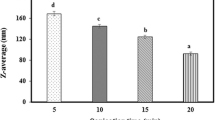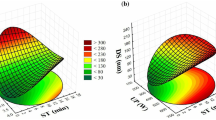Abstract
The aim of the present work was to study the formulation of edible nanoemulsions containing lemongrass essential oil as an antimicrobial agent, Tween 80 as a non-ionic surfactant and sodium alginate as a stabilizing and texturizing agent, by means of a pseudo-ternary phase experimental design. Polynomial models were satisfactory fitted to experimental data. Nanoemulsions with an average droplet diameter smaller than 100 nm were obtained by mixing oil and Tween 80 at a volume fraction below 0.01 (v/v) and higher than 0.009 (v/v), respectively. However, sodium alginate played a synergistic role regarding the stabilization of oil droplets in the absence of surfactant. In this sense, the higher the sodium alginate concentration, the stronger the negative surface charge of lipid droplets, as well as the higher the viscosity of the mixture. On the other hand, the emulsions’ whiteness decreased after increasing the surfactant and decreasing the oil phase, due to weak light scattering. As expected, the antimicrobial activity of blends was greater at higher amounts of essential oil, reaching a maximum of 7.37 log reduction of Escherichia coli after 30 min of contact time. Nevertheless, solubilizing and stabilizing the oil droplets by adding Tween 80 and sodium alginate might enhance the bactericidal effect of essential oils due to an improved dispersion in the continuous phase. The current work presents relevant information to formulate nanoemulsions incorporating antimicrobial agents for food applications.





Similar content being viewed by others
References
Adorjan, B., & Buchbauer, G. (2010). Biological properties of essential oils: an updated review. Flavour and Fragrance Journal, 25(6), 407–426.
Brar, S. K., & Verma, M. (2011). Measurement of nanoparticles by light-scattering techniques. Trends in Analytical Chemistry, 30(1), 4–17.
Burt, S. (2004). Essential oils: their antibacterial properties and potential applications in foods - A review. International Journal of Food Microbiology, 94(3), 223–253.
Cornell, J. A. (2002). Experiments with mixtures: designs, models, and the analysis of mixture data. New York: John Wiley & Sons.
De Gennes, P. G. (1990). Interactions between polymers and surfactants. Journal of Physical Chemistry, 94(22), 8407–8413.
Donsì, F., Annunziata, M., Sessa, M., & Ferrari, G. (2011). Nanoencapsulation of essential oils to enhance their antimicrobial activity in foods. LWT - Food Science and Technology, 44(9), 1908–1914.
Ferreira, J. P., Alves, D., Neves, O., Silva, J., Gibbs, P. A., & Teixeira, P. C. (2010). Effects of the components of two antimicrobial emulsions on food-borne pathogens. Food Control, 21(3), 227–230.
Fisher, K., & Phillips, C. (2008). Potential antimicrobial uses of essential oils in food: is citrus the answer? Trends in Food Science and Technology, 19(3), 156–164.
Friedman, M., Henika, P. R., Levin, C. E., & Mandrell, R. E. (2004). Antibacterial activities of plant essential oils and their components against Escherichia coli O157:H7 and Salmonella enterica in apple juice. Journal of Agricultural and Food Chemistry, 52(19), 6042–6048.
Goddard, E. D. (2002). Polymer/surfactant interaction: interfacial aspects. Journal of Colloid and Interface Science, 256(1), 228–235.
Gómez-Díaz, D., & Navaza, J. M. (2003). Rheology of aqueous soluions of food additives: Effect of concentration, temperature and blending. Journal of Food Engineering, 56(4), 387–392.
Hammer, K. A., Carson, C. F., & Riley, T. V. (1999). Antimicrobial activity of essential oils and other plant extracts. Journal of Applied Microbiology, 86(6), 985–990.
Hessien, M., Singh, N., Kim, C., & Prouzet, E. (2011). Stability and tunability of O/W nanoemulsions prepared by phase inversion composition. Langmuir, 27(6), 2299–2307.
Heurtault, B., Saulnier, P., Pech, B., Proust, J., & Benoit, J. (2003). Physico-chemical stability of colloidal lipid particles. Biomaterials, 24(23), 4283–4300.
Holley, R. A., & Patel, D. (2005). Improvement in shelf-life and safety of perishable foods by plant essential oils and smoke antimicrobials. Food Microbiology, 22(4), 273–292.
Hsu, J., & Nacu, A. (2003). Behaviour of soybean oil-in-water emulsion stabilized by nonionic surfactant. Journal of Colloid and Interface Science, 259(2), 374–381.
King, K. (1994). Changes in the functional properties and molecular weight of sodium alginate following γ irradiation. Food Hydrocolloids, 8(2), 83–96.
Kralova, I., & Sjöblom, J. (2009). Surfactants used in food industry: A review. Journal of Dispersion Science and Technology, 30(9), 1363–1383.
Li, P., & Chiang, B. (2012). Process optimization and stability of d-limonene-in-water nanoemulsions prepared by ultrasonic emulsification using response surface methodology. Ultrasonics Sonochemistry, 19(1), 192–197.
Liang, R., Xu, S., Shoemaker, C. F., Li, Y., Zhong, F., & Huang, Q. (2012). Physical and antimicrobial properties of peppermint oil nanoemulsions. Journal of Agricultural and Food Chemistry, 60(30), 7548–7555.
Maher, P. G., Fenelon, M. A., Zhou, Y., Kamrul Haque, M., & Roos, Y. H. (2011). Optimization of β-casein stabilized nanoemulsions using experimental mixture design. Journal of Food Science, 76(8), C1108–C1117.
Mancini, M., Moresi, M., & Sappino, F. (1996). Rheological behaviour of aqueous dispersions of algal sodium alginates. Journal of Food Engineering, 28(3–4), 283–295.
Mason, T. G., Wilking, J. N., Meleson, K., Chang, C. B., & Graves, S. M. (2006). Nanoemulsions: formation, structure, and physical properties. Journal of Physics Condensed Matter, 18(41), R635–R666.
McClements, D. J. (2011). Edible nanoemulsions: fabrication, properties, and functional performance. Soft Matter, 7(6), 2297–2316.
McClements, D. J. (2005). Food emulsions. Principles, Practices and Techniques. Boca Raton, FL: CRC Press.
McClements, D. J. (2002a). Colloidal basis of emulsion colour. Current Opinion in Colloid and Interface Science, 7(5–6), 451–455.
McClements, D. J. (2002b). Theoretical prediction of emulsion colour. Advances in Colloid and Interface Science, 97(1–3), 63–89.
McClements, D. J., & Rao, J. (2011). Food-grade nanoemulsions: formulation, fabrication, properties, performance, biological fate, and potential toxicity. Critical Reviews in Food Science and Nutrition, 51(4), 285–330.
Neumann, M. G., Schmitt, C. C., & Iamazaki, E. T. (2003). A fluorescence study of the interactions between sodium alginate and surfactants. Carbohydrate Research, 338(10), 1109–1113.
Qian, C., & McClements, D. J. (2011). Formation of nanoemulsions stabilized by model food-grade emulsifiers using high-pressure homogenization: factors affecting particle size. Food Hydrocolloids, 25(5), 1000–1008.
Rao, J., & McClements, D. J. (2012). Lemon oil solubilization in mixed surfactant solutions: rationalizing microemulsion & nanoemulsion formation. Food Hydrocolloids, 26(1), 268–276.
Raybaudi-Massilia, R. M., Mosqueda-Melgar, J., & Martín-Belloso, O. (2008a). Edible alginate-based coating as carrier of antimicrobials to improve shelf-life and safety of fresh-cut melon. International Journal of Food Microbiology, 121(3), 313–327.
Raybaudi-Massilia, R. M., Rojas-Graü, M. A., Mosqueda-Melgar, J., & Martín-Belloso, O. (2008b). Comparative study on essential oils incorporated into an alginate-based edible coating to assure the safety and quality of fresh-cut Fuji apples. Journal of Food Protection, 71(6), 1150–1161.
Ren, S., Mu, H., Alchaer, F., Chtatou, A., & Müllertz, A. (2013). Optimization of self nanoemulsifying drug delivery system for poorly water-soluble drug using response surface methodology. Drug Development and Industrial Pharmacy, 39(5), 799–806.
Rinaudo, M. (2008). Main properties and current applications of some polysaccharides as biomaterials. Polymer International, 57(3), 397–430.
Rojas-Graü, M. A., Raybaudi-Massilia, R. M., Soliva-Fortuny, R. C., Avena-Bustillos, R. J., McHugh, T. H., & Martín-Belloso, O. (2007). Apple puree-alginate edible coating as carrier of antimicrobial agents to prolong shelf-life of fresh-cut apples. Postharvest Biology and Technology, 45(2), 254–264.
Sánchez-González, L., Vargas, M., González-Martínez, C., Chiralt, A., & Cháfer, M. (2011). Use of essential oils in bioactive edible coatings: a review. Food Engineering Reviews, 3(1), 1–16.
Tajkarimi, M. M., Ibrahim, S. A., & Cliver, D. O. (2010). Antimicrobial herb and spice compounds in food. Food Control, 21(9), 1199–1218.
Terjung, N., Löffler, M., Gibis, M., Hinrichs, J., & Weiss, J. (2012). Influence of droplet size on the efficacy of oil-in-water emulsions loaded with phenolic antimicrobials. Food and Function, 3(3), 290–301.
Tiwari, B. K., Valdramidis, V. P., O'Donnell, C. P., Muthukumarappan, K., Bourke, P., & Cullen, P. J. (2009). Application of natural antimicrobials for food preservation. Journal of Agricultural and Food Chemistry, 57(14), 5987–6000.
Tønnesen, H. H., & Karlsen, J. (2002). Alginate in drug delivery systems. Drug Development and Industrial Pharmacy, 28(6), 621–630.
Vargas, M., Cháfer, M., Albors, A., Chiralt, A., & González-Martínez, C. (2008). Physicochemical and sensory characteristics of yoghurt produced from mixtures of cows’ and goats’ milk. International Dairy Journal, 18(12), 1146–1152.
Ziani, K., Chang, Y., McLandsborough, L., & McClements, D. J. (2011). Influence of surfactant charge on antimicrobial efficacy of surfactant-stabilized thyme oil nanoemulsions. Journal of Agricultural and Food Chemistry, 59(11), 6247–6255.
Acknowledgments
This study was supported by the Ministerio de Ciencia e Innovación (Spain) throughout the project AGL2009-11475. Laura Salvia-Trujillo thanks the Ministry of Science and Education (Spain) for the predoctoral grant. Prof. Olga Martín-Belloso thanks the Institució Catalana de Recerca i Estudis Avançats (ICREA) for the Academia 2008 Award.
Author information
Authors and Affiliations
Corresponding author
Rights and permissions
About this article
Cite this article
Salvia-Trujillo, L., Rojas-Graü, M.A., Soliva-Fortuny, R. et al. Formulation of Antimicrobial Edible Nanoemulsions with Pseudo-Ternary Phase Experimental Design. Food Bioprocess Technol 7, 3022–3032 (2014). https://doi.org/10.1007/s11947-014-1314-x
Received:
Accepted:
Published:
Issue Date:
DOI: https://doi.org/10.1007/s11947-014-1314-x




